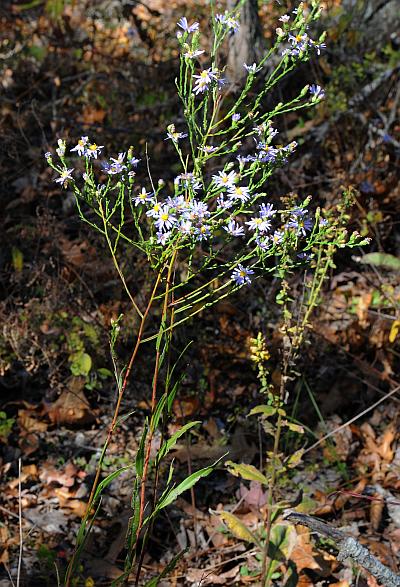Symphyotrichum oolentangiense (Riddell) G.L. Nesom
Azure Aster

Native
CC = 7
CW = 5
MOC = 63
© SRTurner
Symphyotrichum oolentangiense (Riddell) G.L. NesomAzure Aster | |
 |
Native CC = 7 CW = 5 MOC = 63 |
© SRTurner |
|
Family - Asteraceae/Astereae Habit - Perennial forb, usually from a short, stout, somewhat branched and sometimes woody rootstock, occasionally also producing short rhizomes. Stems - Ascending to erect, to 1.2 m, single or multiple, unbranched or with few to several ascending branches above the midpoint, glabrous or sparsely to moderately roughened with short, spreading hairs in longitudinal lines or bands, mostly toward the stem tip.
Leaves - Alternate, simple, mostly petiolate. Basal and lower leaves present at flowering, long-petiolate, the petiole sometimes narrowly winged (often only toward the tip), the blade 4-18 cm long, 1-5 cm wide, heart-shaped or occasionally ovate, deeply cordate to less commonly truncate or abruptly rounded at the base, angled or tapered to a sharply pointed tip, the margins entire or with a few minute, widely spaced teeth, moderately to densely roughened with minute, stiff hairs on the surfaces, the secondary veins on the leaf undersurface often irregularly fused toward their tips, the veinlets often indistinct, forming a dense, irregular network of relatively short areoles. Median and upper stem leaves progressively smaller, with long to short, often winged petioles or the uppermost leaves sessile, the blades 1-6 cm long, narrowly ovate to narrowly lanceolate, rounded to tapered at the base, otherwise similar to the lower stem leaves.
Inflorescence - Panicles with relatively long, loosely ascending, racemose branches, sometimes with denser heads along the branches or reduced to a solitary raceme, the heads appearing short-or long-stalked. Bracts along the ultimate branches 0.3-0.8 cm long, leaflike, mostly linear, noticeably shorter and narrower than the adjacent foliage leaves.
Heads - Radiate, mostly 1.5-2.5 cm in diameter. Involucre 4.5-8.0 mm long, the bracts in 4-6 unequal, overlapping series. Involucral bracts linear to narrowly lanceolate or narrowly oblong, angled or short-tapered at the mostly sharply pointed tip, the tip erect or ascending (the lowermost bracts occasionally slightly spreading), the slender midvein broadened relatively abruptly in the apical 1/5-1/3 (rarely more) into an elliptic or broadly diamond-shaped green tip, the outer surface glabrous or sparsely short-hairy, the margins moderately hairy, especially toward the tip.
Flowers - Ray florets pistillate, 10-25 per head in 1 or 2 series, the corollas well developed, 6-12 mm long, lavender to purple to blue. Disc florets perfect, 15-28 per head, the corollas 4-5 mm long, the slender portion of the tube shorter than the slightly expanded apical portion, the lobes 0.4-0.7 mm long, 20-25 percent of the total length of the expanded portion. Pappus bristles 3.5-5.0 mm long, off-white to pale cream-colored, occasionally purplish-tinged.
Fruits - Achenes 1.5-2.0 mm long, mostly with 4 longitudinal ribs, purplish brown, often with lighter ribs, glabrous or sparsely hairy. Flowering - August - November. Habitat - Glades, upland prairies, sand prairies, savannas, upland forests on rocky slopes, ledges and tops of bluffs, roadsides. Origin - Native to the U.S. Lookalikes - Broadly, several other purple-rayed asters. Other info. - This distinctive species can be found scattered throughout most of Missouri, most commonly in the southern half of the state. Beyond Missouri its range comprises a band extending from Texas and Louisiana northward through the Great Lakes region and into Canada. It is an easily identified aster due to the long, narrow, arrowhead-shaped lower leaves which are rough and sandpapery to the touch. The blue-purple rays and green diamond-tipped phyllaries help also. Plants with glabrous stems can be growing right next to those with hispidulous stems, so stem pubescence is not a good character to use for identification. This species is characteristic of glades and upland prairies. Photographs taken in Eminence, MO., 9-21-03 (DETenaglia); also at Victoria Glade, Jefferson County, MO, 10-11-2010 and 10-7-2020, St. Francois State Park, St. Francois County, MO, 10-24-2011, and Peck Ranch Conservation Area, Carter County, MO, 10-17-2015 (SRTurner). |